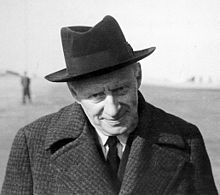Charles Wilson, 1st Baron Moran
|
The Right Honourable The Lord Moran MC PRCP |
|
|---|---|

Charles McMoran Wilson c. 1943
|
|
| President of the Royal College of Physicians | |
|
In office 1941–1949 |
|
| Preceded by | Sir Robert Hutchinson |
| Succeeded by | Walter Russell Brain |
| Member of the House of Lords as Baron Moran |
|
|
In office 8 March 1943 – 12 April 1977 |
|
| Preceded by | Peerage created |
| Succeeded by | John Wilson |
| Personal details | |
| Born |
10 November 1882 Skipton |
| Died | 12 April 1977 (aged 94) Newton Valence |
| Spouse(s) | Dorothy Dufton MBE 1919 – 1977 (his death) |
| Children |
John Geoffrey |
| Alma mater | St Mary's Hospital Medical School |
Charles McMoran Wilson, 1st Baron Moran, MC, PRCP (10 November 1882 – 12 April 1977) is most famous for being Sir Winston Churchill's personal physician.
Moran was born in Skipton, Yorkshire, young son and youngest of three children of John Forsythe Wilson, a physician and general practitioner from northern Ireland, and his wife Mary Jane, daughter of the Reverend John Julius Hannah, a Presbyterian minister of Clogher.
He was educated at Pocklington Grammar School then studied medicine at St Mary's Hospital Medical School, now the Imperial College School of Medicine, graduating with a MBBS in 1908. He took his MD degree in 1913 at the same medical school. As a student he played in the college rugby fifteen as well as at county level for Middlesex.
He enlisted in the Royal Army Medical Corps in the First World War, rising to major. He was medical officer to the 1st Battalion of the Royal Fusiliers from 1914 to 1917 and medical officer in charge of the medical facilities at the British 7th Stationary Hospital in Boulogne from 1917 to 1918. He won the Military Cross in 1916 for services during the Battle of the Somme, and the Italian Silver Medal of Military Valour in 1917 and was twice mentioned in despatches. At the end of war he researched into the effects of mustard gas.
Longer term, based on his frontline experience, he developed his study into the effects of wartime conditions on the resilience of troops which was published in the 1930s as a series of lectures titled The Mind in War and culminated in a book The Anatomy of Courage, published in 1945 at the end of the Second World War. He lectured on courage to officer students at the Staff College in Camberley.
...
Wikipedia
